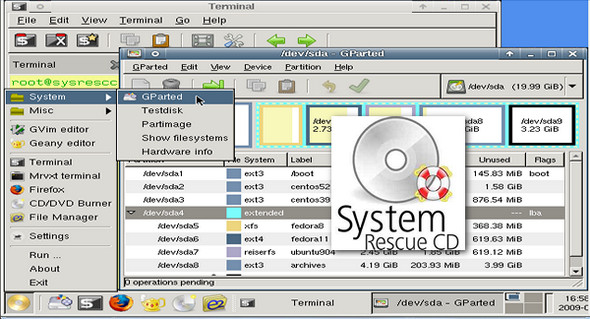
- #Wikipedia SystemRescueCD mac os#
- #Wikipedia SystemRescueCD archive#
- #Wikipedia SystemRescueCD software#
- #Wikipedia SystemRescueCD password#
- #Wikipedia SystemRescueCD plus#
There was an -L switch mentioned, but it was said to be dangerous and could potentially lead to data loss. So again I read man pages for xfs_repair. Now this would make sense, since the TeraStation has a PowerPC processor and the server uses two Xeon processors. Wikipedia told me some unimportant stuff about it, and at the bottom of the page (where the fuck else?) there was a note that mentioned that xfs is actually dependant on the architecture (i386, x86_64 etc.) and that I’d have to “clear” the journal when migrating to another architecture. So I decided to read me a little into what XFS is. I yum-installed xfstools and tried xfs_check and xfs_repair, but none helped. Mounting that external drive on our server failed though with the message “xfs unknown file system”. Now guess what, the TeraStation uses XFS for the external drives. But hey, we have that external hard drive that the TeraStation makes its backups on, right? Right. Also, I couldn’t mount the samba shares with mount.cifs on another server, because the samba shares obviously were gone.ĭisassembling the TeraStation and connecting its hard drives to another computer wouldn’t make sense because a RAID array is being used. There is rsync on the TeraStation, but it can’t be used to transfer files over the network, because – as I mentioned before – there’s no SSH. A few months earlier, I hacked the crontab (a “little” security hole in that firmware) which let me run a script with root privileges, so I managed to chmod the /etc/sudoers to 777 and – finally – get root access. Unfortunately, the TeraStation does not ship with SSH, but I was able to get into it via telnet. So, anyway, the data stored on the TeraStation was very important and needed to be accessed. Just as advice: NEVER EVER BUY SUCH CRAP! Yes, I was root, I was owner, smb.conf had 777, everything. I could also echo stuff > smb.conf – it would always stay 0 bytes in size. I could edit it with vi (you don’t have vim on that minilinux) and save, nothing would happen. It couldn’t be accessed from Windows machines anymore because the smb.conf was completely empty. Now the TeraStation was horribly, almost hilariously damaged. It was connected to a Buffalo TeraStation (that’s a NAS, sort of, with a super small linux). The DVD can then be used to insert those files into the hard drive using Midnight Commander.Today I experienced one of these problems: My colleague in Berlin had that external hard disk drive. This should not affect the general way in which the DVD works. To burn the DVD, one must burn the image file first and then add all the separate files and folders. This makes it good for storing all the information that is needed from a hard drive and then formatting it. The CD can also boot from a customized DVD which has almost 4.6 GB of free space for backed-up files. Can boot FreeDOS, Memtest86+, hardware diagnostics and other boot disks from a single CD.
#Wikipedia SystemRescueCD password#
Support for Windows Registry editing and password changing from Linux.Ability to create a boot disk for operating systems.Support for Intel x86 and PowerPC systems, including Macs.
#Wikipedia SystemRescueCD mac os#
#Wikipedia SystemRescueCD plus#
#Wikipedia SystemRescueCD archive#

#Wikipedia SystemRescueCD software#
PartImage - disk imaging software which copies only used sectors.GNU Parted and GParted to partition disks and resize partitions, including FAT32 and NTFS.It has options such as connecting to the Internet through an ADSL modem or Ethernet and graphical web browsers such as Mozilla Firefox. SystemRescue is capable of graphics using the Linux framebuffer option for tools such as GParted. Starting with version 6.0, it has systemd as its init system. It was designed by a team led by François Dupoux, and is based on Arch Linux since version 6.0. It runs from a Live CD, a USB flash drive or any type of hard drive. SystemRescue is not intended to be used as a permanent operating system. The primary purpose of SystemRescue is to repair unbootable or otherwise damaged computer systems after a system crash. SystemRescue (Previously known as " SystemRescueCD") is a Linux distribution for x86 64 and x86 computers.


 0 kommentar(er)
0 kommentar(er)
